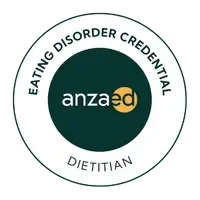What to Eat in Binge Eating Recovery (No Food Rules Approach)
Jun 11, 2025
If you’ve ever typed this into Google after a binge or when you're trying to “get back on track,” you’re not alone. This is one of the most common questions I hear from clients at the very start of their recovery journey — and honestly, it makes total sense.
You want to feel better. You want clarity. And deep down, you want to stop feeling out of control with food.
But here’s the twist:
However, from a binge specialist dietitian, this is a question with a misleading premise.
Why “What Should I Eat or Avoid?” Isn’t the Real Question
This question seems simple. But hidden underneath it are layers of food rules, fear of weight gain, and a desire for control.
What you're really asking might be:
- “How can I stop feeling addicted to food?”
- “How do I eat without spiraling into another binge?”
- “How do I eat like a normal person again?”
And those are beautiful, valid questions. But unfortunately, they can't be answered by a clean-eating shopping list or another rigid meal plan.
To really stop binge and compulsive eating, we need to focus on rebuilding a relationship with food that’s flexible, nourishing and safe. So that food becomes just food again, and the sign for you to heal? Not thinking “what can I eat” & “what I can’t eat”
The How - RAVES
Let’s talk about building the foundation for HOW to eat
This is where the RAVES model comes in — a gentle nutrition framework developed by dietitian Shane Jeffrey to support recovery from disordered eating and chaotic eating patterns.
It’s not a rulebook. It’s more like scaffolding — helping your body and brain feel safe again with food.
RAVES stands for:
R - Regular Eating
Eating every 3–4 hours gives your body consistent energy, reduces “hangry” decision-making, prevent the extreme hunger that often leads to bingeing, and help your body learn that food is sufficient, turning off the survival-based eating
A - Adequate Eating
Yes, you need enough food, and often means eating more. Skimping on portions or skipping meals keeps your body in survival mode. Recovery requires fuelling your body with the energy it needs — especially if you’ve spent years under-eating or restricting.
V — Variety
Eating variety means being able to eat ALL foods and not feel guilty and not giving into binge. The key is to gently challenge your diet rules and trigger foods, so all foods becomes just foods.
E — Eating Socially
Eating with others helps normalise eating pattern and ease the isolation that fuels your binge & compulsive eating. It’s okay to start small — like having a snack during a Zoom call or lunch with a trusted friend.
S — Spontaneous Eating
Being spontaneous around eating is the final step of the healing process. It can feel scary at first, especially if you’ve relied on rigid eating rules. But spontaneous eating builds trust and confidence in your body around food.
It means saying yes to an unplanned muffin with coffee, or suddenly change what you’ve planned for lunch accordinb to your body’s natural hunger and fullness cues.
Think of RAVES like stabiliser wheels for your food relationship. It’s not forever — but it helps you ride steady while you heal.
So… what should I eat to help me end binge eating?
The short answer? - Anything
But I know - that answer feels vague, even scary, when you’ve spent years seeing food through the lens of “allowed” vs “off-limits”
Let’s make this more tangible. Here are five types of food I encourage my clients to explore and embrace:
1. Foods That Provide Steady Energy
Think about meals that contains carbs, protein, fats and fibres - they tends to help you stay satisfied, stable, and binge-free throughout the day
Examples:
- Spag bol with grilled veggies
- Tofu skewer with coleslaw in pita bread
- Peanut butter on toast + banana
- Muesli with yogurt and berries
2. Foods You Actually Enjoy
Satisfaction is essential in recovery. Eating food you like helps reduce cravings and prevent the urge to “keep searching” after a meal. Make your tastebuds your recovery teammate
3. Easy, Accessible Meals
You don’t need to eat picture-perfect meals every day. Simple, convenient options make eating feel less overwhelming — which is key when motivation or time is low. Think about what are easy and satisfying.
Example :
- Cereal with milk
- Get a toasties from cafe instead of grocery shopping + prepping during busy times
- Get a range of crackers, cheese, fruit & nutsas snacks instead of searching for the best option
4. Previously “Off-Limits” Foods
Foods that were once forbidden often trigger binges when reintroduced abruptly. But with support, mindfulness and structure, these can be brought back in safely.
This might include:
- Chocolate
- Ice cream
- Bread
- Fast food
The goal isn’t to eat these all the time — it’s to remove their power so you can choose them mindfully.
5. Comfort Foods
Yep, these belong too. Using food for comfort sometimes is normal — and doesn’t mean you’re emotionally broken. Food is connection, memory, and warmth.
It’s okay to enjoy that bowl of mac and cheese — with compassion, not shame.
And… anything to avoid?
Here’s the part where most blogs would list sugar, processed food, or gluten.
But what you should really avoid is things that prevent you from trusting your own body around food again. They are…
1. Food rules that disguised as “Health”
Rules like “No eating after 7pm,” “Only clean food on weekdays,” or “No carbs unless I’ve worked out” seem innocent — even virtuous.
But here’s the truth: rules are meant to be broken. The stricter the rule, the stronger the backlash.
And for many, that backlash looks like a binge.
Instead of rigid rules, try gentle structure:
✨ “I usually feel better when I eat something every 3–4 hours.”
✨ “I feel more satisfied when my meals include carbs, protein, and fat.”
2. Restriction (Even Mental Restriction)
You might not be skipping meals anymore. But if your inner dialogue still sounds like:
- “I shouldn’t have eaten that.”
- “I need to make up for this tomorrow.”
- “That was too much.”
…your body still senses danger.
Mental restriction triggers the same sense of deprivation as physical restriction — and it fuels the same urge to binge.
Recovery requires full permission to eat — without shame, bargaining, or conditions.
3. Self-shaming and criticism
You can’t hate yourself into healing.
Berating yourself after a binge (“What’s wrong with me?” “I have no control”) only deepens the shame spiral — and makes the next binge more likely.
Instead, practice compassionate curiosity: 💬 “What was going on before the binge?” 💬 “Did I eat enough earlier in the day?” 💬 “What did I really need in that moment?” Remember: shame blocks learning. Self-compassion builds trust.
4. Labelling foods as “Good” or “Bad”
When food is morally loaded, so is eating. And when eating becomes a test of whether you’re being “good” or “bad,” it disconnects you from what you actually need.
Labeling foods fuels guilt, fuels binge urges, and makes satisfaction feel unsafe.
Instead, try food neutrality:
🍕 Pizza is pizza, a food.
🥦 Broccoli is broccoli, a food.
🍫 Chocolate is chocolate, a food.
🥖 Bread is bread, a food.
All have a place. All can nourish in different ways.
5. Avoid All-or-Nothing and Perfectionistic Thinking
Recovery isn’t a light switch. It’s more like a dimmer — gradual, wobbly, and imperfect.
But perfectionism tells you:
❌ “You messed up — you may as well keep bingeing.”
❌ “You ate something bad — start over Monday.”
This black-and-white thinking is what fuels the restrict-binge-punish-repeat cycle.
Try this reframe instead:
💬 “One snack, one meal, one choice doesn’t define my whole day.”
💬 “Progress isn't perfect — and I’m still moving forward.”
Takeaway: Recovering from binge & compulsive eating is about Addition, not Subtraction
Rather than asking, “What should I cut out?”, try asking:
- What would help me feel more nourished today?
- What food would feel satisfying — emotionally and physically?
- What thought or belief could I loosen my grip on?
The path to freedom isn’t paved with rules. It’s paved with trust, permission, and a whole lot of compassion.
Need Support on This Journey?
If you’re tired of food rules, guilt, and getting stuck in the binge–restrict cycle — and you’re ready for lasting change — come join my free webinar: 3 Steps to End Overeating.
With just one hour of your day, you will learn:
- Reason Why you Struggle with Constant Cravings (it’s not a lack of willpower)
- 3 Mistakes that Keep You Stuck in the Binge Cycle
- 3 Essential Steps to End Binge & Emotional Eating (where tools like RAVES and other evidence-based strategies are baked right in)
- The Exact Tools I Teach My Clients to Break Free from Binge & Overeating
This is your first step toward food freedom — no restriction, no shame, no perfection required.












